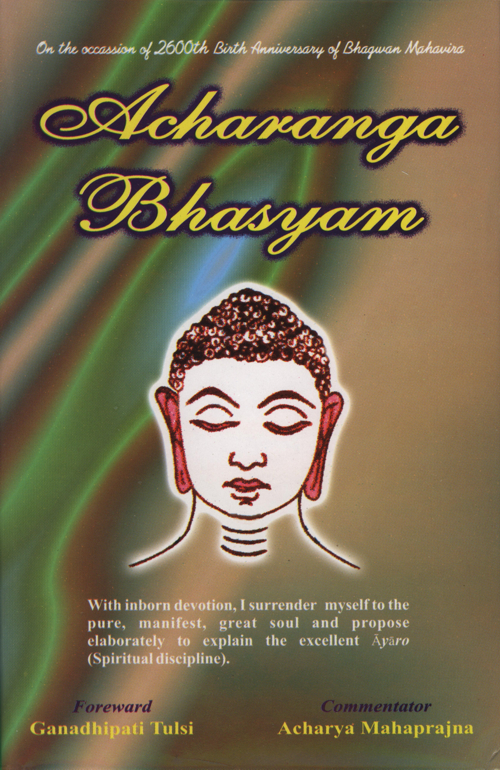6.52 ihamegesiṃ egacariyā hoti.
Some monk practise the discipline of solitary life.
Bhāṣyaṃ Sūtra 52
Lord Mahāvīra has propounded two kinds of monastic discipline: For a non-adepted monk, discipline of a religious order has been recommended. The adept monks however undertake the practice of solitary discipline with the approval of the learned preceptor.
6.53 tatthiyarāiyarehiṃ kulehiṃ suddhesaṇāe savvesaṇāe.
They collect alms from various families ascertaining its purity and completeness.
Bhāṣyaṃ Sūtra 53
Collecting alms from various families, after carefully and thoroughly ascertaining its purity and completeness without any arbitrary preference,[1] he should wander in a village or a town suitable for a monk's dwelling.
'Pure alms' means free from attachment.
'Complete alms' means all the seven types of deportments of alms-taking.[2]
The monks are of two classes: those belonging to a particular order and others who are outside the order. The purity of alms is for the monks outside the order and the completeness of alms is prescribed for monks within the order. All the seven kinds of deportments of alms-begging are recommended for the monks who live with in the order.
For those who are outside the order, the first two are prohibited, while the last five are open to selection.[3]
6.54 se mehāvī parivvae.
The wise monk should practise the discipline and wander.
Bhāṣyaṃ Sūtra 54
The wise monk should wander without attachment to any place. A monk practising solitary asceticism should not have any permanent abode.
6.55 subbhiṃ aduvā dubbhiṃ.
He should tolerate pleasant or unpleasant sounds.
Bhāṣyaṃ Sūtra 55
Such monk should tolerate the pleasant or the unpleasant sound that he may hear during his intense asceticism at a cemetery. The terms 'pleasant'[4] and 'unpleasant'[5] may refer to smell, but here the subject matter[6] is not concerned with the food and so that meaning is irrelevant. In the following Sūtra it is said that there may either be dreadful sights and sounds around him.[7] The term 'there' in the Sutra refers to the cemetery.
In the following Sūtra which reads 'or one should not be afraid of at the sight of dreadful objects there (in the cemetery),' the word 'or' refers to either pleasant or unpleasant, and therefore, there is the implication of sounds and not smells. In the Nāyadhammakahāo Sūtra, the words pleasant and unpleasant are found qualifying smell as well as sound (1/12/9).[8] In the intensive course at the cemetery, the troubles related to sound and the like are possible of occurrence indeed.[9]
6.56 aduvā tattha bheravā.
Or one should not be afraid of at the sight of dreadful objects there (in the cemetery).
Bhāṣyaṃ Sūtra 56
Or, 'there' means 'is in the intensive austerities in the cemetery', dreadful sights[10] may occur. 'Dreadful' means terrible sights. It has been said in the Daśavaikālika, after adopting the intensive course in the cemetery, the monk should not be afraid of the dreadful sights that inspire fear.[11]
6.57pāṇā paṇe kilesaṃti.
Cruel beings torture the creatures.
Bhāṣyaṃ Sūtra 57
In the Sūtra, the nature of beings has been described, as there prevails the law of the strong killing the weak. For instance, a big fish devours the small fish, so the cruel animals and birds are killing the weaker one.[12] Among humans also, such nature prevails. The cruel humans push other humans in a miserable conditions.[13]
6.58 te phase puṭho dhīro ahiyasejjāsi. - tti bemi.
The patient monk afflicted by such touches should endure them. - Thus do I say.
Bhāṣyaṃ Sūtra 58
While wandering or during the intensive course at the cemetery, when he is afflicted by the aforementioned touches, the patient monk should tolerate the desirable or undesirable touches. 'Patient' means unpolluted, unagitated and 'like one enduring equanimously the cut of an axe and the smearing by the sandalwood paste'.[14]
Pravacanasāroddhārasya vṛttāvapi (patra 215) ayaṃ vibhāgo dṛśyate - iha ca dvikoṭikāḥ sādhavo gacchāntargatā gacchanirgatāśca, tatra gacchāntargatānāmetāḥ saptāpi grahītumanujñātāḥ, gacchanirgatānāṃ punarādyayoḥ dvayoragrahaḥ paṅcasvabhigrahaḥ.
(a) Ācarāṅga Cūrṇi, p.215: subbhiṃ ahavā dubbhiṃ, gaṃdhakāmapariccāgo bhaṇito.
(b) Ācārāṅga Vṛtti, patra 220: sa āhārasteṣvitareṣu kuleṣu surabhirvā syāt athavā durgandhaḥ, na tatra rāgadveṣau vidadhyāt'.
(b) Cūrṇau (p.215) 'ahavā tattha viharaṃtassa' iti vyākhyātamasti.
(b) Vṛttau bhairavapadena prādhānyena śabdā eva gṛhītāḥ santi - bhairavā bhayānakā yātudhānādi-kṛtāḥ śabdāḥ prādurbhaveyuḥ, yadi vā 'bhairavāḥ' ‘bibhatsāḥ'. (Ācārāṅga Vṛtti, patra 220)
 Acharya Mahaprajna
Acharya Mahaprajna

